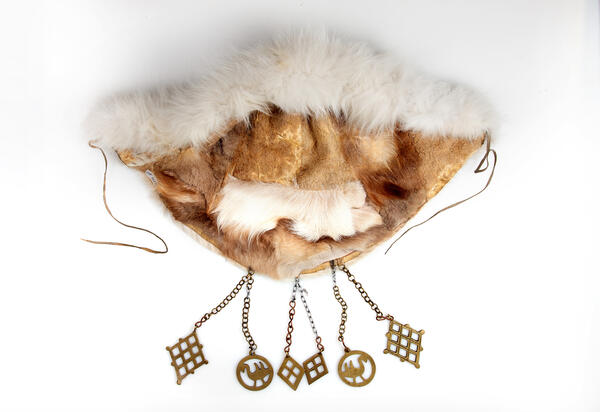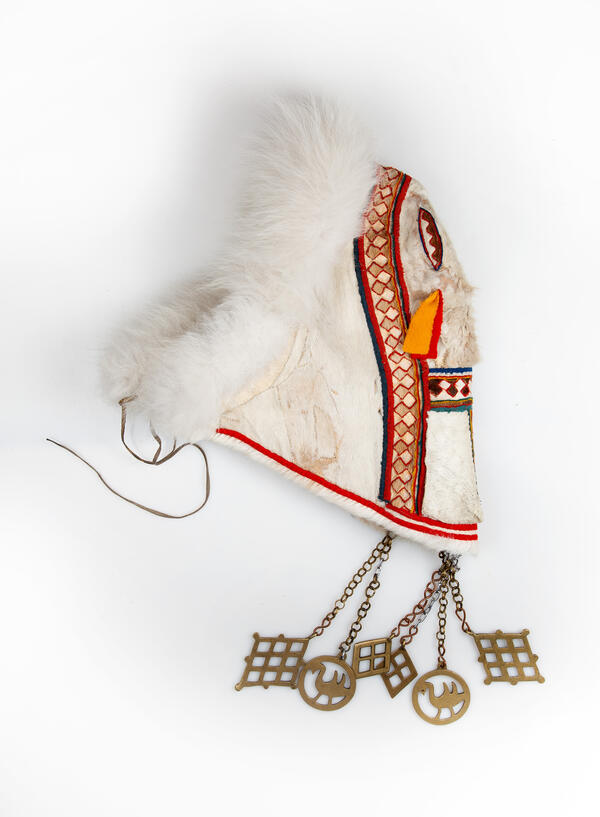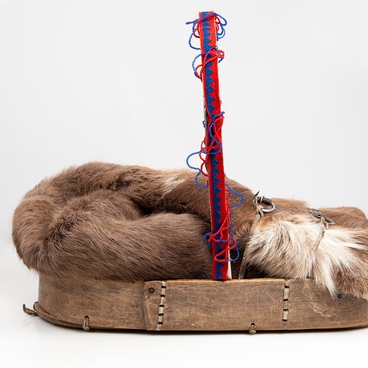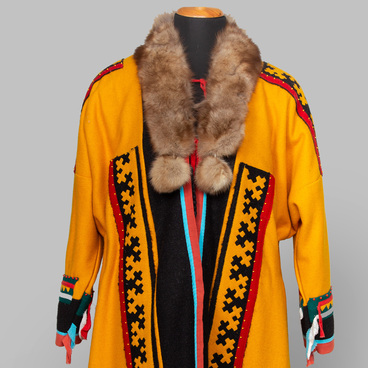In the Yamalo-Nenets Autonomous Okrug, winter lasts up to eight months, and frosts reach 50 degrees Celsius. Making warm outerwear is part of the traditional Nenets culture, a prerequisite for surviving in the Arctic climate. Women pass down sewing techniques and skills from generation to generation. Men’s outerwear is called a “malitsa”, and women’s — a “panitsa” or “yagushka”. This is a long shirt, made of cloth or fur, with a slit in the front. It takes up to ten reindeer skins to make one winter panitsa.
A women’s hat or hood is an addition to the winter panitsa. Elderly Nenets women wear high hats made of young reindeer skins, lined with calfskin. The hats are round at the top and have short ear flaps, they are similar in cut to men’s headwear. Festive hats are trimmed with cloth: square or triangular patches of different colors are sewn along the seams — around the top and on the sides. The ends of the fabric bands hang loosely. Two long strips made of the hard skin from the lower leg of a deer are sewn at the back. They are lavishly decorated with mosaic ornaments of white and dark furs, as well as cloth inserts. In the middle, the ears flaps are connected to each other with copper chains or threads.
Young Nenets women and teenage girls wear a different type of hats. This is a high headdress of a semicircular shape, sewn from the fur of a young deer with a lining from the abdominal part of the deer hide. The top of the hood is made from the skin removed from the deer’s forehead. The hood is sewn with the eye sockets on the back — they are decorated with the fur of a contrasting color. Bright strips of cloth are inserted along the semicircular seam, and additional ear flaps are sewn on the back — this is a attribute of festive clothes. The long ear flaps are not tucked into the belt, they hang loosely over the panitsa reaching below the waist.
A lot of copper and iron jewelry with slotted and embossed patterns, as well as large beads, are sewn on leather straps or chains from the back to the lower edge of the hood. These ornaments pull the sides of the hat back, pressing them against the fur coat, so that cold air does not get under the fur. When walking, the pendants make a gentle rattling sound. The front of the hat is tied under the chin with leather straps. The Nenets hat is soft, light, warm and big enough. Modern Nenets wear a warm hood for riding deer, and when working outdoors they prefer fur shawls.
A women’s hat or hood is an addition to the winter panitsa. Elderly Nenets women wear high hats made of young reindeer skins, lined with calfskin. The hats are round at the top and have short ear flaps, they are similar in cut to men’s headwear. Festive hats are trimmed with cloth: square or triangular patches of different colors are sewn along the seams — around the top and on the sides. The ends of the fabric bands hang loosely. Two long strips made of the hard skin from the lower leg of a deer are sewn at the back. They are lavishly decorated with mosaic ornaments of white and dark furs, as well as cloth inserts. In the middle, the ears flaps are connected to each other with copper chains or threads.
Young Nenets women and teenage girls wear a different type of hats. This is a high headdress of a semicircular shape, sewn from the fur of a young deer with a lining from the abdominal part of the deer hide. The top of the hood is made from the skin removed from the deer’s forehead. The hood is sewn with the eye sockets on the back — they are decorated with the fur of a contrasting color. Bright strips of cloth are inserted along the semicircular seam, and additional ear flaps are sewn on the back — this is a attribute of festive clothes. The long ear flaps are not tucked into the belt, they hang loosely over the panitsa reaching below the waist.
A lot of copper and iron jewelry with slotted and embossed patterns, as well as large beads, are sewn on leather straps or chains from the back to the lower edge of the hood. These ornaments pull the sides of the hat back, pressing them against the fur coat, so that cold air does not get under the fur. When walking, the pendants make a gentle rattling sound. The front of the hat is tied under the chin with leather straps. The Nenets hat is soft, light, warm and big enough. Modern Nenets wear a warm hood for riding deer, and when working outdoors they prefer fur shawls.





